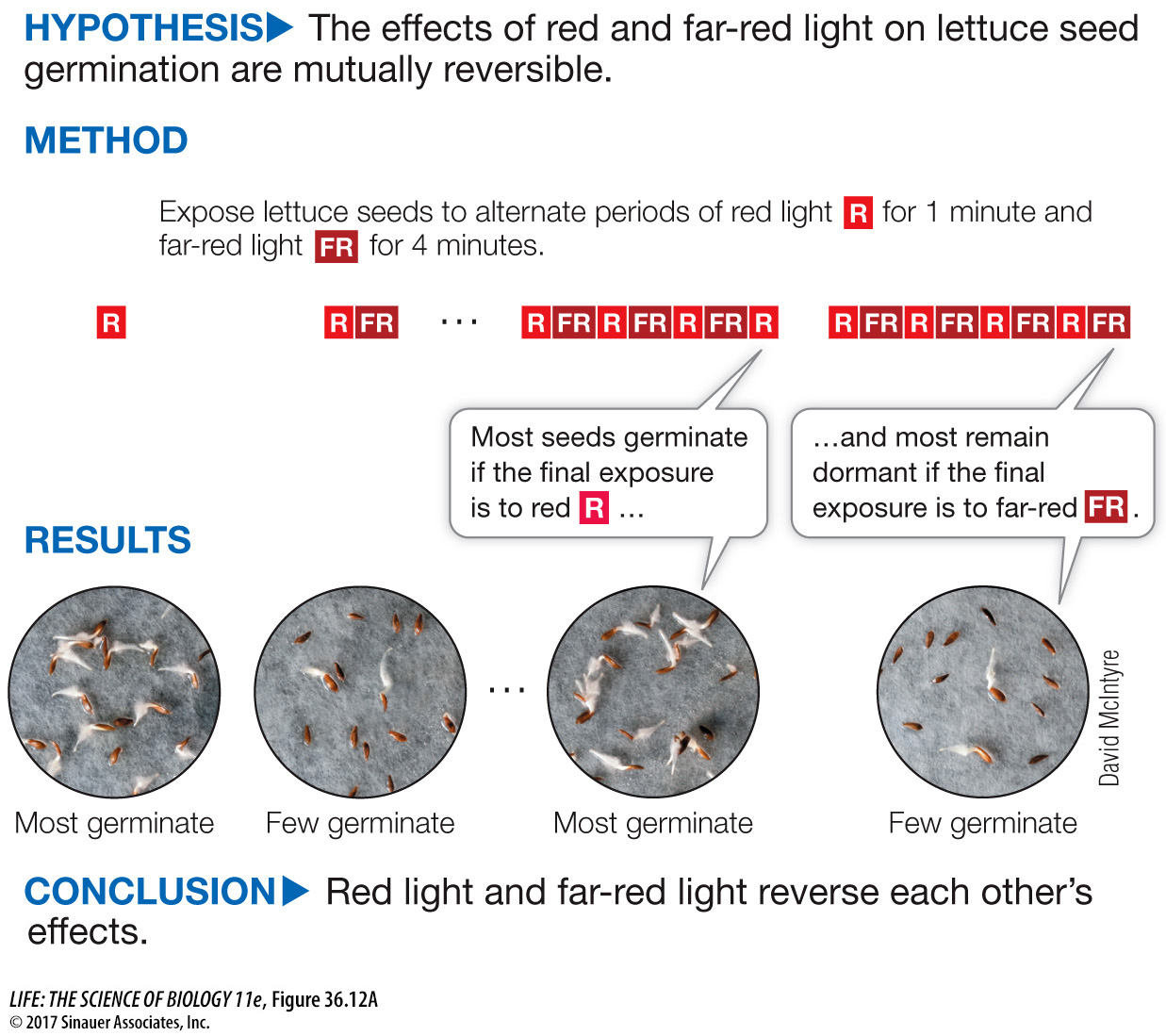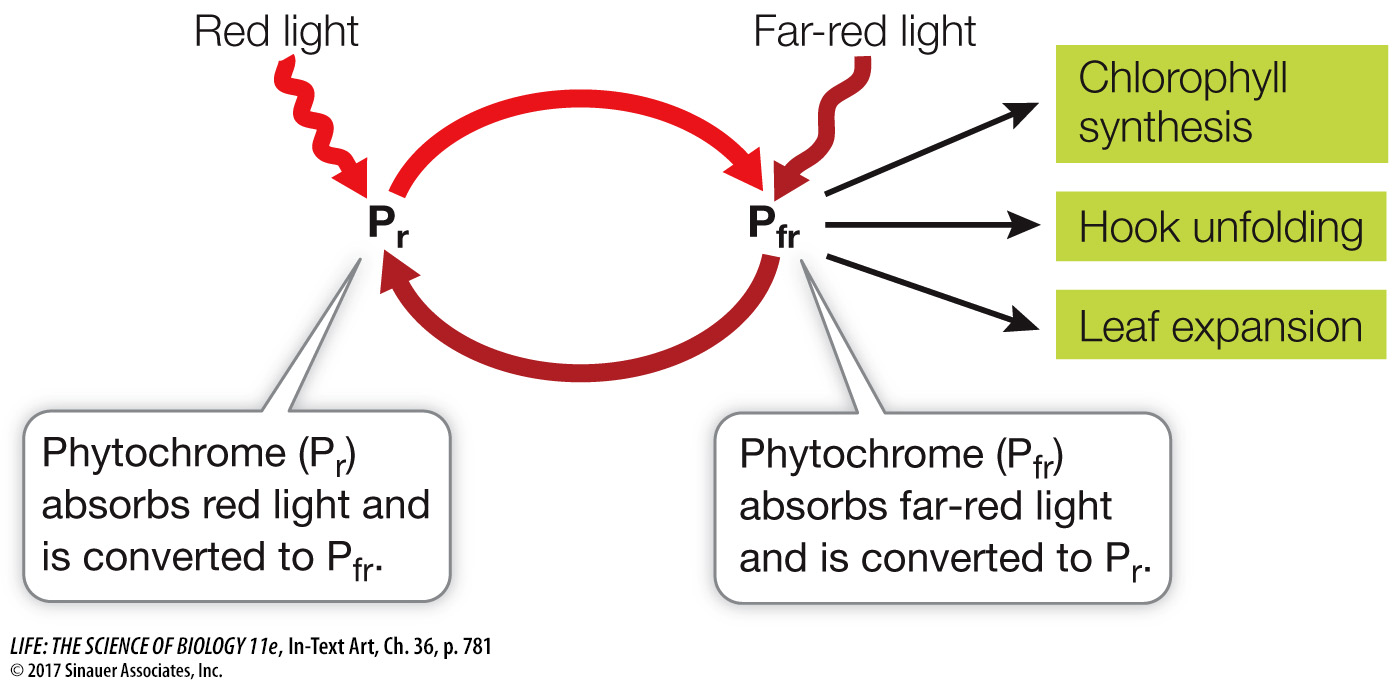Phytochromes mediate the effects of red and far-
Photomorphogenesis refers to a number of physiological and developmental events in plants that are controlled by light. For example:
A bean seedling germinating belowground has an elongated stem, a pale yellow, folded leaf, and a hook that protects the first leaves (see Figure 36.1 and p. 778)—it is etiolated. As the seedling reaches the surface of the soil, it undergoes several light-
induced changes: the apical hook straightens, the rudimentary leaves unfold, and chlorophyll is made, so that photosynthesis can begin. Even very dim light will induce these changes. Lettuce seeds spread on the soil will germinate only in response to light. Even just a flash of dim light will suffice.
Adult cocklebur plants flower when they are exposed to long nights. If there is a brief light flash in the middle of the night, they do not flower.
Action spectra of the above processes show that they are induced by red light (650–
What is especially remarkable about these red light responses is that they are reversible by far-
experiment

Figure 36.12A Sensitivity of Seeds to Red and Far-
Original Paper: Borthwick, H. A., S. B. Hendricks, M. W. Parker, E. H. Toole and V. K. Toole. 1952. A reversible photoreaction controlling seed germination. Proceedings of the National Academy of Sciences USA 38: 662–
Lettuce seeds will germinate if exposed to a brief period of light. An action spectrum indicated that red light was most effective in promoting germination, but far-
work with the data
Figure 36.12B Sensitivity of Seeds to Red and Far-
Original Paper: Borthwick, H. A. et al. 1952.
Harry Borthwick, Sterling Hendricks, and colleagues at the U.S. Department of Agriculture performed a series of landmark experiments that suggested the existence of a receptor for red light that determined seed germination. Borthwick was the son of a leading plant pathologist who followed in his father’s footsteps and studied plant physiology. After it was discovered that plants responded to the length of day (photoperiodism; see Chapter 37), the importance of nonphotosynthetic responses to light as a developmental signal became a hot topic of research. For over a century, it was known that lettuce seeds required light to germinate. By placing lettuce seeds in an environment where other environmental variables such as temperature were controlled, Borthwick’s group tested the light signaling on germination.
QUESTIONS
Question 1
An action spectrum (see Figure 10.4) for seed germination was obtained by first soaking the seeds on wet filter paper in the dark for 16 hours for imbibition, and then exposing them to different wavelengths of light for 1 minute. Having been exposed to a possible germination signal, the seeds were returned to the dark and tested for germination after 2 days. The results are shown in Table A in terms of energy efficiency (how much light energy was required for 50% seed germination).
Explain the energy efficiency measurement: what do high and low numbers mean?
Plot the data as energy efficiency versus wavelength. What can you conclude about the most efficient wavelengths of light for germination?
| Wavelength (nm) | Energy required for 50% seed germination |
|---|---|
| 560 | 35 |
| 570 | 25 |
| 580 | 15 |
| 590 | 10 |
| 600 | 8 |
| 620 | 6 |
| 640 | 4 |
| 660 | 3 |
| 680 | 4 |
| 690 | 45 |
| 700 | 80 |
A high number means that more light energy at that wavelength is needed for the response (see germination) than a low number.

The highest efficiency was in the red part of the visible spectrum (600–680 nm).
Question 2
There was evidence from other light signaling responses in plants that the light effects were reversible by exposure to different wavelengths of light. After the data in Table A were obtained, Borthwick’s team decided to first expose groups of 200 seeds to light at 660 nm (red, R) for 1 minute, and then some batches to light at 700 nm (far-
What can you conclude about the nature of the light signal responder?
Why was there some germination in the “None” condition?
| Wavelengths used | Percent germination |
|---|---|
| None | 8.5 |
| R | 98 |
| FR | 54 |
| R then FR then R | 100 |
| R then FR then R then FR | 43 |
| R then FR then R then FR then R | 99 |
The photoreceptor has two forms that reversibly interconvert: red light stimulates the formation of the active receptor, and far-
A small amount of phytochrome was in the P-
A similar work with the data exercise may be assigned in LaunchPad.
781
The basis for the effects of red and far-

The part of phytochrome that absorbs red and far-

The absorption spectra for Pr and Pfr correlate with their action spectra (Figure 36.13B). As you have seen, phytochrome affects seed germination, shoot development after etiolation, and flowering. In Arabidopsis there is a gene family that encodes five slightly different phytochromes, each functioning in different photomorphogenic responses.
For a plant in nature, the ratio of red to far-
In daylight the ratio is about 1.2:1; because there is more red than far-
red light, the Pfr form predominates. In the shade of other plants, the ratio is as low as 0.13:1, and phytochrome is mostly in the Pr form. The low ratio of red to far-
red light in the shade results from absorption of red light by chlorophyll in the leaves overhead, so less of the red light gets through to the plants below.
782
For some plants growing in the shade, the low ratio stimulates cell elongation and the plants grow upward toward the sun. The shade cast by other plants also prevents germination of seeds that require red light to germinate. The reflective properties of the soil can also affect the red to far-